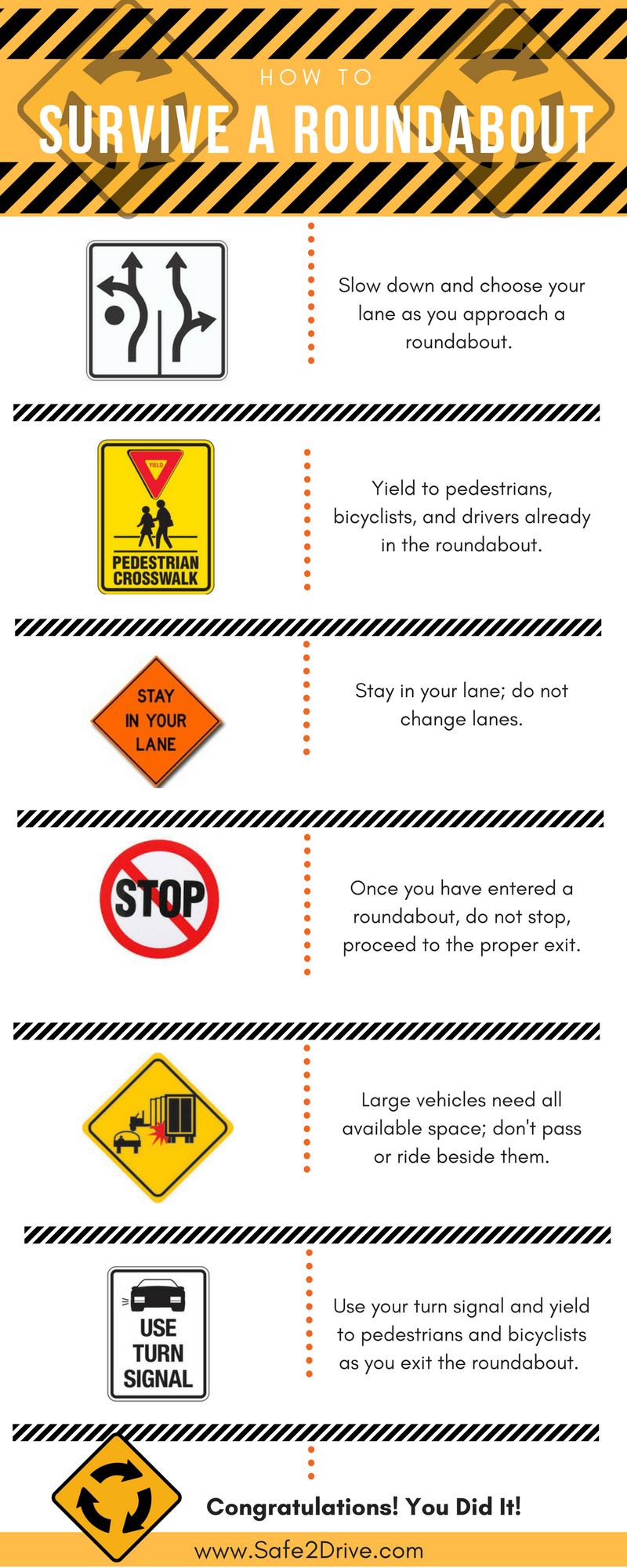
Many states and counties are installing roundabouts to reduce congestion and improve safety at intersections. Roundabouts are new to many of us, and the problem is the total lack of understanding for most American drivers. It’s confusing and dangerous when people don't clearly understand how to navigate through a roundabout intersection.
There are a few key things to remember about driving roundabouts:
- Yield to drivers already in the roundabout.
- Stay in your lane; do not change lanes.
- Do not stop in the roundabout.
- Avoid driving next to oversize vehicles.
- Be sure to use your turn signal when exiting.
How to Use Roundabouts
As you approach a roundabout, you will see a yellow "roundabout ahead" sign with an advisory speed limit for the roundabout. In a multi-lane roundabout, you will also see a black-and-white "lane choice" sign. You will need to choose a lane before entering the roundabout.
You choose your lane in a multi-lane roundabout the same way you would in a traditional multi-lane intersection. To go straight or right, get in the right lane. To go straight or left, get in the left lane. Drivers can also make U-turns from the left lane.
Slow down as you approach the roundabout, and watch for pedestrians and bicyclists in the crosswalk.
Continue toward the roundabout and look to your left as you near the yield sign and dashed yield line at the entrance to the roundabout. Yield to traffic already in the roundabout.
Once you see a gap in traffic, enter the circle and proceed to your exit. If there is no traffic in the roundabout, you may enter without yielding.
Make sure to stay in your lane as you navigate the roundabout.
If you miss your exit, continue around the roundabout again and exit.
Look for pedestrians and bicyclists in the crosswalk and use your turn signal before exiting.
Trucks/Oversize Vehicles and Roundabouts
Because large vehicles may need extra room to complete their turn in a roundabout, drivers should remember never to drive next to large vehicles in a roundabout.
Roundabouts are designed to accommodate vehicles of all sizes, including emergency vehicles, buses, farm equipment and semi-trucks with trailers. Oversize vehicles and vehicles with trailers may straddle both lanes while driving through a roundabout.
Many roundabouts are designed with a truck apron, a raised section of pavement around the central island that acts as an extra lane for large vehicles. The back wheels of the oversize vehicle can ride up on the truck apron so the truck can easily complete the turn, while the raised portion of concrete discourages use by smaller vehicles.
Pulling Over for Emergency Vehicles
If you have not yet entered the roundabout, pull over to the right and let that approaching emergency vehicle pass.
If you are already in the roundabout, get out at the nearest exit, drive past the splitter island and then pull over to allow the emergency vehicle to clear the roundabout. Don't stop inside the roundabout.
Roundabouts Are Safer Intersections
Studies show that major intersections that were converted to roundabouts had:
- 38% reduction in all crashes
- 40% reduction in pedestrian and cyclist incidents
- 76% reduction in injuries
- 90% reduction in fatalities
Roundabouts Are a Safer Alternative to Traffic Signals and Stop Signs.
The tight circle of a roundabout forces drivers to slow down, and the most severe types of intersection crashes (right-angle, left-turn and head-on collisions) are unlikely.
Roundabouts Improve Traffic Flow and Are Better for The Environment.
Research shows that traffic flow improves following conversion of traditional intersections to roundabouts. dLess idling, and less stopping and going, reduces vehicle emissions and fuel consumption.d
Roundabouts Are Safer for Pedestrians.
Pedestrians walk on sidewalks around the perimeter and cross only one direction of traffic at a time. Crossing distances are relatively short, and traffic speeds are lower than at traditional intersections.
